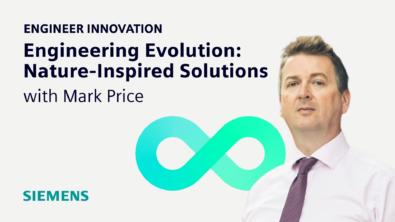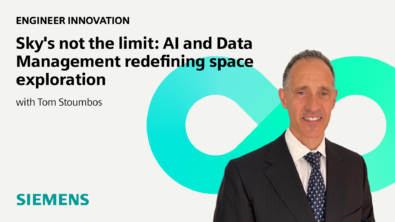Experiencing the Digital Twin in the Industrial Metaverse – with Virginie Maillard (Series 2 Episode 3)
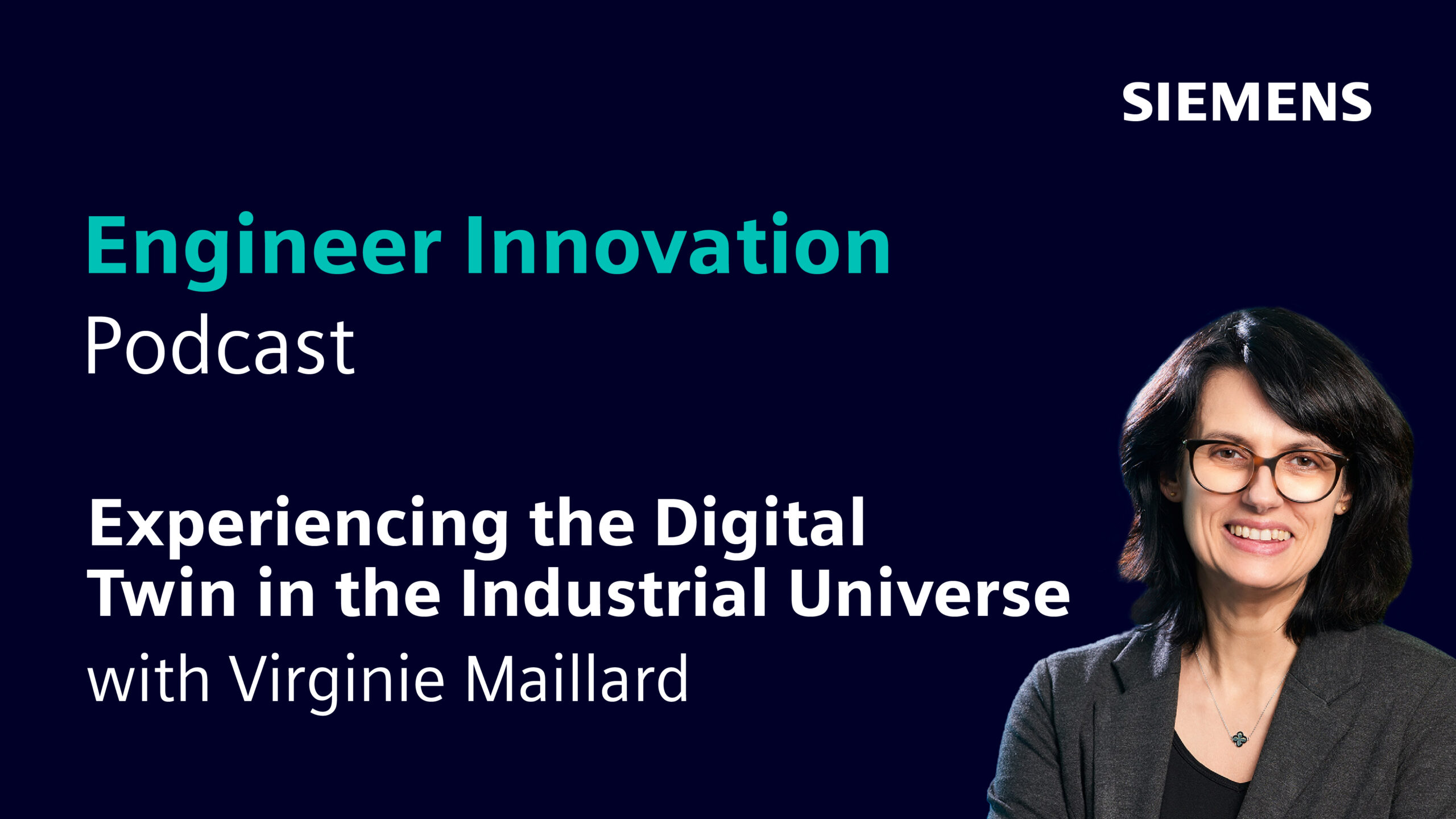
On today’s episode of the Engineer Innovation podcast, we’re joined by Virginie Maillard, Head of Global Research in Simulation and Digital Twin at Siemens. She’s here to talk about the role of the digital twin in the emerging industrial metaverse and what the future holds.
We talk about:
- What is a digital twin and what type of digital twin models are there?
- What kind of research is taking place around digital twin models?
- What is the industrial metaverse? How is different from other types of metaverses?
- How digital twin models can be used in the industrial metaverse.
- What companies can gain from moving to the industrial metaverse.
- How does sustainability factor into the industrial metaverse?
- What do the next few years hold for digital twin models?
This episode of the Engineer Innovation podcast is brought to you by Siemens Digital Industries Software — bringing electronics, engineering and manufacturing together to build a better digital future.
If you enjoyed this episode, please leave a 5-star review to help get the word out about the show.
For more unique insights on all kinds of cutting-edge topics, tune in to siemens.com/simcenter-podcast.
- What are digital twins and what type of digital twins are there?
- What kind of research is taking place around digital twins?
- What is the industrial metaverse? How is different from other types of metaverses?
- How digital twins can be used in the industrial metaverse.
- What companies can gain from moving to the industrial metaverse.
- How does sustainability factor into the industrial metaverse?
- What do the next few years hold for digital twins?
Chad Ghalamzan 00:12
Welcome to The Engineering Innovation podcast, powered by Simcenter. I’m your host, Chad Ghalamzan. This podcast is a show by engineers for engineers, in which we explore how engineering simulations and tests are contributing to a healthier, happier and more sustainable future. Our guests bring in-depth knowledge of their specialty, and we have engaging conversations about the past, present, and future of engineering. We’ve got a really exciting topic today, the role of the digital twin in the emerging industrial metaverse. Most of us have heard the term metaverse, but I wouldn’t be surprised if you’ve never heard the term “industrial metaverse” before. You probably want to jot that down for future reference. If the proponents of it are right, they believe it has the potential to revolutionize the world in a way that few technologies can. And here to help us understand that is Virginie Maillard, Head of Global Research in Simulation and Digital Twins at Siemens. Hello Virginie, how are you?
Virginie Maillard 01:08
Hello Chad.
Chad Ghalamzan 01:10
So, maybe you could tell us a little bit what your day-to-day is like, what does the head of digital twin and simulation do?
Virginie Maillard 01:17
Well, and you know, my team is spread out in four countries, US in Germany, India, China. So you know, my daily job is to be connected to them, visit them sometimes, and also be connected to our research partners. Because as a central research of Siemens, we are connected to academics and universities all around the world, and also to our business units. And my job is really to make the link between state-of-the-art knowledge valuable in the academic labs, and to make the link to the business of Siemens.
Chad Ghalamzan 01:49
So why research? What are we researching with digital twins? I mean, digital twins are not new. So what is the research in digital twins covering or involving?
Virginie Maillard 02:00
Research is a long journey, and you don’t start and stop like that. It’s a long quest, and doing simulation for 30 years, I started as an [inaudible] engineer and mechanical engineer. And today, I can see the evolution of simulation over the years, and there are still a lot of topics to research.
Chad Ghalamzan 02:18
What kind of evolution are you talking about?
02:21
The main topics we are looking at in my team are digital twin at operation — how to bring the simulation to operations because today is more design. The second part is the interoperability — have the digital twin all along the lifecycle. And the third part is industrial metaverse — that is more engaging, at least more immersive experience. And we’re going to talk about later today.
Chad Ghalamzan 02:47
Yeah, that’s definitely a big topic of interest. When again, we’re talking about digital twins to start off with, and maybe even that term, there’s so much confusion around it. So maybe we could put that in context a little bit for the conversation. When we say digital twin, especially from a Siemens point of view, what exactly do we mean by digital twin?
Virginie Maillard 03:08
In Siemens, we define the digital twin as a virtual representation of a real physical system that integrates whole data models and information we have in the system all along the lifecycle. It combines the real world and the digital world, in a comprehensive source of information you can use to predict [inaudible]. This is the best definition we have of a more complete definition we have.
Chad Ghalamzan 03:35
Yeah, and maybe we can expand a little bit on what we mean by real-world data because I think that’s a key difference here, right? It’s not just a digital representation. It’s the data that makes the difference.
Virginie Maillard 03:46
Yes, and that’s why you’re sort of lifecycle component of this definition is important because, you know, at the very beginning you have a digital twin you can use as a digital prototype to design some new products. You don’t have a test data at that time. The second part of the digital twin journey is how your manufacturer will sustain your design into digital twin at production. And the third part is the digital twin at operation. Two systems you can operate, and you can have a digital twin. And in this touch, we have a lot of data. That’s why the full concept of digital twin is all along the lifecycle. You have this digital twin exchanging datas, [inaudible] or measured, and they are more or less available along the lifecycle, depending on the stage you are at. And the holistic, or comprehensive, digital twin is a full system, design or manufacturing and operation, exchanging data simulation between each other.
Chad Ghalamzan 04:43
What does that data exchange? Give us because that’s a lot of data. And we’re exchanging data between those three different phases. But what does that allow us to do that we couldn’t do? We just had a digital model without that data.
Virginie Maillard 04:55
Definitely, it’s a combination between real world and digital world. In the digital world, we have physics, we have models coming from the mathematics and physics of what we know about the world. And the real test data brings us additional information. But the opposite is proved too. That’s why sometimes you cannot measure content when you don’t have access to some test data because it’s just not possible to measure. And then the physics brings you additional information. That’s why, for me, it’s really a combination between physics and the real world. Together they are comprehensive, the most up-to-date information about your system.
Chad Ghalamzan 05:32
Why do you think there’s so much confusion around that term? That why do you think there’s so many different definitions of digital twin floating around?
Virginie Maillard 05:38
You know, our digital twin is a large concept, as I explained. And there are plenty of definitions because companies usually take the definition of digital twin that fits the best with the scope of their own business. And I think the common understanding everybody agrees on, is that digital twin is all about combining together the real world and the digital world. And this is a reason why Siemens is a very strong position from digital twin because we have a lot [inaudible].
Chad Ghalamzan 06:08
Building on that concept, what’s the difference between a digital twin and an executable digital twin?
Virginie Maillard 06:13
Executable digital twin is a particular type of digital twin that consists in a reduced model that you can package, implement on a device, and then you run in the HR. It can be executed fast enough to serve real-time operations. This is an executable digital twin. And they are plenty of families of executive digital twin. One of my preferred ones are virtual sensors to simulate what you cannot measure of a system. For example, really high temperatures, temperature of a moving part you cannot measure. Then you can create a kind of synthetic data to complete missing test data. Then you can, like, augment control loop capabilities of your machine, for example. And it’s extremely powerful.
Chad Ghalamzan 07:00
So these virtual sensors, is that the only application of the executive digital twin, or are we seeing that in use in other ways?
Virginie Maillard 07:07
No, you have different families, as I said. And it could be used also to optimize, in factory offices, for example, or to [inaudible]. That’s why there are different usage of this. But the common component is the fact that we are able to simulate on physics. We can reduce this model in a proper way and package and implement on the device. The difficulty here is to keep the accuracy you need. That’s why the conversation is really key in this process to keep the accuracy you need on the [inaudible].
Chad Ghalamzan 07:40
We’re talking about digital twins and we’re talking about executable digital twins, and there already seems to be a blurring of the digital and the real world here. Is that a fair statement?
Virginie Maillard 07:51
Yeah, I like this statement. Because, you know, it’s a complete system, interacting with each other. And this is exactly what we understand from the digital twin.
Chad Ghalamzan 08:00
So, I guess things are about to get a little bit more blurry because I think that’s where the industrial metaverse comes in and really breaks down the differentiation between the real world and the digital world. So maybe you could start by telling us, from a student’s point of view again, what is the industrial metaverse?
Virginie Maillard 08:17
The industrial metaverse from Siemens’ perspective is a virtual immersive 3D setting that reproduces real physical system with a proposal to solve real-world problems. This is the definition of Siemens because we really claim the fact that we combine the real and digital world, again. And that’s why, also, the digital twin represents the foundation of [inaudible].
Chad Ghalamzan 08:43
Right? So I mean, the term “metaverse,” it’s been thrown around for a lot of different things. So industrial Metaverse, though, is special. So let’s maybe clarify a little bit more. What is different about the industrial metaverse versus, let’s say, the commercial metaverse or the entertainment side of it, or the commercial side of it for maybe other business collaborations?
Virginie Maillard 09:04
First of all, thanks for asking this question because it’s really important to differentiate the different types of metaverse because there is a lot of excitation around at this very moment. And it’s good to extract out of it the real vision of Siemens. First of all, we have a first category for retail and entertainment coming from the gaming industry and the social media. We can call it “consumer metaverse”. The second category is virtual workspace or office collaboration. If you want to interact in virtual life with avatars, like we’re doing today, but it’s “enterprise metaverse”. And the third category is “industrial metaverse” that is dedicated to the design and operation of real-world systems like factories, buildings and transportation. And this is the one we are talking at Siemens, and we are looking at.
Chad Ghalamzan 09:54
What’s the value of doing that then? I mean, it’s great, we’re talking about a metaverse, and it sounds like we’re adding another layer of representation to things. But what’s the value in doing that?
Virginie Maillard 09:55
And, as I said, you know, today, we already combine the real and digital realms in the form of a comprehensive digital brain that provides already great value to our customers. And definitely a fast program identification solution, improvement of quality, sustainable products, and so on. Your question is interesting because what is the additional value of the industrial metaverse on top of that? Definitely, it depends on the use case, or the purpose, of your chosen digital metaverse. And you’re right, we don’t need to be 3D immersed all the time. We don’t need to be in immediate interaction with each document all the time. But in some cases, yes. Let me give you some examples.
Chad Ghalamzan 10:46
Yeah, that might be helpful. An example might help us understand exactly what we can do in a 3D immersive space, that we couldn’t do right now. Because there are a lot of collaboration tools. I mean, I’m in Montreal, you’re in an office in New Jersey. We’re not in the same place and we’re collaborating. Obviously, we’re not doing something complex like tackling an engineering problem, but we could do a lot of collaboration already. So what would getting into an industrial metaverse allow us to do that we couldn’t do with, let’s say, using an online meeting, and file sharing and all the other cloud collaboration tools we already have?
Virginie Maillard 11:18
Now, it’s definitely, your metaverse is a place to experiment with digital twin. When I say experience, let me give you some example. For example, if wants to visualize the digital twin. Let’s say you are in a factory, and you want to … with a tablet, you can display operation data on top of the machine. Then you have an augmented understanding of what’s going on, then you can fix some problem quickly. This is a really concrete usage of industrial metaverse. And as you can see, it’s nothing crazy, it’s already more or less existing, but it’s another level of immersion. Another example is when you want to design some product, and you are more in interaction with a digital twin in real time. Let’s say you are a designer and you want to be able to visualize the concept in 3D to turn around, maybe make some modification and see in real time the effect of your modification. And for example, to see the effect on aerodynamic performance of what you have changed. The value here is really to accelerate the creation of innovative and high-performance products, and then to short-term the time to market.
Chad Ghalamzan 12:26
So you’re saying, in the industrial metaverse, we could be at a digital factory, simulating the digital manufacturing process on getting a digital version of that product before we actually invest any real world assets or resources into it?
Virginie Maillard 12:41
A concrete example is, let’s say you have a team of manufacturing experts all around the world, and they want to fix a problem or maybe to optimize a new layout of a factory and then they are able to collaborate around the digital twin on the factory to decide some modifications together. The two need to be in person in the real place. Perhaps it’s more complex. Then it’s, for me, an industrial metaverse gives you an additional experience, we leverage better the digital twin.
Chad Ghalamzan 13:11
So this connectivity between the real world and the digital world in the metaverse is made possible by a digital twin. So having real data connected to our digital twin allows us to do this. Having an understanding of the real-world assets we’re trying to digitize is important. What other technologies are necessary to make this additional metaverse a possibility?
Virginie Maillard 13:38
You know, Siemens already provides many of the foundational technologies to enable the metaverse such as IoT, AI, 5G and blockchain, Edge computing, cybersecurity security, very important, and also, high fidelity simulation software. All these packages of technology are already key to enabling the metaverse. On top of that, we benefit from the gaming industry that has paved the way of the new technologies like graphic cards, unprecedented performance, providing proper realistic synthetic images. We want AR/VR devices, standalone and easy to use, compared to 10 years ago. Also Cloud and Edge computing, high-speed internet, we are able to exchange a large amount of data, can perform now simulations. These are all the technologies coming together, at this very moment, to make a reality that through metaverse is happening now.
Chad Ghalamzan 14:35
So have you personally experienced something in the industrial metaverse?
Virginie Maillard 14:40
So, you know, my team is a team of researchers, and we want to experience this immersion. That’s why we tested some platforms of meeting enterprise metaverse. I was talking about to have a meeting in virtual life. Honestly, it’s not easy because we have to find another way to interact with the code, and to take some notes, for example, or to interact. But we are experiencing, for a little bit more than a year now. That’s why, yes, we’re experiencing. And the second month, coming into the industrial metaverse, we are also making some proof of concept of the industrial metaverse applied to industry, typically in an industrial environment, for factories and also from design.
Chad Ghalamzan 15:21
So it’s still emerging. Like we said, it’s not fully developed, this is the shape of things to come.
Virginie Maillard 15:27
So at this very moment, we consider it as a vision because it’s an evolution of what we’re already doing today. As I said already, we are doing digital twin for our customers, we are already providing a lot of value in our, with our digital twin. That’s why it’s an evolution to one thing more immersive, more interactive. And we are living this revolution, this evolution that is running online.
Chad Ghalamzan 15:52
What makes you confident about this vision? I mean, you sound very confident that this is the way the evolution will unfold. But there is a certain degree of uncertainty here. So what makes you so confident that this is the megatrend that will shape us, let’s say, for the next decade or more?
Virginie Maillard 16:08
As you said, it’s a megatrend. And it’s not happening. We have today some hypes, many fueled by social media and internet. But the evolution of technologies is very slow. As I said, I’m looking at those simulation rules and topics for some years. And I see the slow evolution toward more fast simulation, toward more interactive tools like in AR/VR, and it’s coming slowly, but it’s coming surely. And it’s coming, also to focus together. I like to say that innovation happens at a point because all enablers are available at the right time. And it is now for the industrial metaverse. It is now because all of the hardware and software we are working on for many, many years are now at a certain maturity to be able to go further. This is the beauty of the topic.
Chad Ghalamzan 17:00
Yeah, there’s a term called the “adjacent possible” which means there has to be enough available technology to drive and innovation. And so until certain building blocks are known you can’t take that leap forward. So what you’re describing is pretty much that, that we have several matured technologies that have existed for a little while that have reached a level that we can bring them together and perhaps create the industrial metaverse and it’s still being formed. And it’s still a vision of what we’d like to come. And there’s maybe some things we can concretely do as a stepping stone towards that. But do you think it will be step increments? Or do you think it will be more of a revolution, where in a swift movement, we’ll see a large number of early adopters move towards something like the industrial metaverse?
Virginie Maillard 17:45
I think the industrial metaverse will offer enormous potential to transform our economies and industries. I don’t know if you’d call it a revolution, but it’s definitely an important change in the way we are going to work and the way we’re going to design products, to manufacture products, to operate and send additional tools and augmentations of our capabilities. But again, it’s nothing crazy new because we’re already doing this with our digital twin.
Chad Ghalamzan 18:15
So we’re talking about the vision of Siemens to create this industrial metaverse. And there’s other players out there who are aligned with us. For a customer or for someone who now wants to enter the industrial metaverse and start leveraging some of the technology, the digital twin, and all the other aspects of what we’re offering, to utilize it. Besides having an immersive experience, is there value to them to proceed this way? And what’s the net gain to someone investing in going this direction? Because again, it’s emerging, and it’s not necessarily something that will be shaped the way you’ve described. But like all technology, you have to usually be an early adopter to reap the fruit of it early on. So what would a customer gain by moving towards the industrial metaverse with us right now?
Virginie Maillard 19:00
You know, before talking about investment, at this very moment, we’d encourage companies to try and learn, as soon as possible, to make their mind up about the potential for their business about the industrial metaverse. This is a key question, at this very moment, and it’s not about the technologies we’ve already discussed. It’s, we need to find it and additional value, how it’s going to definitely change the way we work in our industry. And metaverse does not exist yet. But we are already using and implementing many of the technologies that will define it in the future. As I said, if 5G, AI, Edge, digital twin, and the concept of industrial metaverse is also strongly related to industrial digitalization strategies of our customers. For example, the way they integrate IT and OT with this system, but also the ecosystem, interoperability, flexibility, the openness of the solution they want to implement in their industry. They are all ingredients who enabled the industrial metaverse. That’s why, how you invest in these solutions and implement them today, will also define how you can work in the industrial metaverse in the future. It’s already a continuum.
Chad Ghalamzan 20:11
So would it be fair to say that extraordinary complex real-world problems being represented digitally is one way to leverage the metaverse to its full potential? And perhaps look for solutions with these really complex problems. And that space, that you wouldn’t necessarily achieve by collaborating in a normal way that we are now. Is that the level of complexity that allows us to capture one of the big advantages to the industrial metaverse?
Virginie Maillard 20:40
Definitely. When I say, the industrial metaverse is a place to experience the digital twin, though really a tool, a way we are going to use to interact better with the digital world. We want to visualize, we want to interact and we want to collaborate in this virtual environment. And of course, if you can test multiple scenarios in a virtual life before going to real test. Of course, you gain time, and you are going to be efficient, and you create an innovative product faster. Of course, if you can solve some problem because you have a virtual environment of the factory, for example. And you have to fix a problem remotely. You can interact with the industrial metaverse, act in virtual life and test some solutions, before acting in a real factory. And then you can also optimize your operation. That’s why it’s a rare pool of possibility, it’s so large actually. And then so large applications that we’re still to explore.
Chad Ghalamzan 21:37
So it’s like the ultimate sandbox. The ultimate place where we could play and try ideas. Do what-if, and test crazy notions, but no real world repercussions.
Virginie Maillard 21:47
And you can imagine the power to test what-if scenarios in a massive way. To do crazy modifications of your product you could not imagine in real life, just because you can do it in virtual life. And then when you are sure, then you can go to the real world.
Chad Ghalamzan 22:02
So we recently interviewed Ian McGann on this podcast, and he talked about massive data-engineering analytics. And one thing he said was that companies struggle to turn data into decisions. So does the industrial metaverse offer an answer to that problem? Does the industrial metaverse allow us to bring in massive amounts of data in a way that is structured and organized, and allows us to gain insights from it because it is presented in a visual way, presented in a real-world way with real data? But in a digital form. So we can extrapolate, again, from these what-if scenarios, something that you can’t do just looking at data that’s being provided, you know, graphs and charts and field plots and all these values that we get out of our simulations now. Is this the answer to maybe helping to organize and contextualize and possibly even further extrapolate and take decisions from massive amounts of engineering data?
Virginie Maillard 23:00
Engineering data are part of the digital twin. As I said, that is composed of typical models, but also data measured on real world, and together they representative [inaudible]. And they are implemented in the industrial metaverse. So that’s why the answer is, yes. It will be a tool where you can visualize better your digital twin, wherever it comes from, and however it is composed, from physical or measured data.
Chad Ghalamzan 23:29
And since we’re talking about something that’s completely digital, and there’s no real world. There’s real-world data, but we’re not talking about the real world. In the industrial Metaverse, is there an opportunity to maybe look at sustainability in a different way than we’ve been able to right now in terms of tackling it and reducing carbon emissions?
Virginie Maillard 23:45
Now definitely there are plenty of examples. We see simulation, digital twins and the industrial metaverse are key tools to go to more sustainable futures for our industries. And you understand, that if you can test multiple scenarios quickly and find the best solution for your product, then you manufacture only the best one you have selected. You save a lot of material, and the time of experimentation, and resource associated with those. Of course, if you have a problem in a factory line, instead of sending experts from around the world, maybe they can connect to the industrial metaverse and together find the solution around the virtual factory line. And we save a lot of trouble and associated CO2 emissions. And finally, you can also constantly optimize your operations with your digital twin and instrumental metaverse. You can increase efficiency and save energy. That’s why a lot of sustainability components and added value will start with using digital twin and metaverse so for these shared applications.
Chad Ghalamzan 24:50
There’s a concept in Star Trek called the holodeck, where pretty much you can create anything you imagine. Is the industrial metaverse a stepping stone towards that? Creating a completely immersive experience where everything behaves like in the real world. But it’s all imaginary. It’s all digital. Are we building the holodeck In some ways?
Virginie Maillard 25:14
Right? And you know, it exists already with … and you have seen some tablets with a digital twin. You can project like a building, you can put it on your table and you can see it. You can walk around, you can extract some information. You can go inside. Today, we already have an ultrapallet of tools like that.
Chad Ghalamzan 25:35
So, in five years from now, what do you see the industrial Metaverse being, compared to where it is today? Do you think it will be more mature and something that we’re all talking about on a daily basis? Will it still be in its infancy? Tried to build it up? What do you think the next five years holds for the industrial metaverse?
Virginie Maillard 25:56
You know, I see it as a continuum. It’s an evolution we see, we’re already doing digital twin in real life for customers. We’re already providing a lot of customer value. And it’s just a continuation towards more immersive, more interactive tools. And in five years, I hope, yes, I see that we’ll be able to provide more and more tools in such a way. And it’s not a revolution, it’s really an evolution of what we’re already doing today.
Chad Ghalamzan 26:23
Do you think that everything will have a digital twin in five years from now? Everything in the real world will have a digital equivalent? There’ll be a digital twin of us in some space working and maybe doing this podcast in five years from now?
Virginie Maillard 26:37
We could wish, of course. But as I said, it all depends on the investment in digitalization in some industries. And it’s again, it’s a long journey. That’s why, you know, I don’t think it all, everything will be available in five years. But we are underway, and maybe next time we’ll have this interview in 3D spaces, with avatars.
Chad Ghalamzan 26:58
Maybe, but for now, I’d say nothing beats the real you. I appreciate your time today. It’s been a very interesting discussion. There’ll be links to the resource material mentioned in today’s show notes. So thanks again for listening and keep up for the next episode.
Virginie Maillard 27:14
Thank you, Chad. Bye. Bye bye.
Chad Ghalamzan 27:18
Thank you for listening to the Engineer Innovation podcast, powered by Simcenter. If you liked this episode, please leave a five-star review. And be sure to subscribe so you never miss an episode.
Guy de Carufel 27:29
Looking to connect with a like-minded community of thinkers, doers and change-makers. Are you a technical user, process leader, deployment manager or partner in the aerospace defense, energy or transportation industry? Join us from Jun 12 to 15 in Las Vegas, Nevada, for Realized Live Americas or from July 10 to 12 in Munich, Germany, for Realized Live Europe. You’ll have access to breakout sessions, research-orientated workshops, demos, hands-on training and much more. Learn more@events.sw.siemens.com

Chad Ghalamzan – Host
Chad Ghalamzan is a computer engineer with over two decades of experience in sales and marketing for the simulation and test industry. He co-hosts the Engineer Innovation podcast and creates content for Siemens Digital Industries Software. He didn’t start the fire.

Virginie Maillard – Guest
Virginie Maillard has headed the global research activities in Simulation and Digital Twin of Siemens Technology since June 2018. She works at the Siemens Technology office of Princeton, NJ, and leads teams in Germany, India and China.
In May 2019, she was also appointed Head of Siemens Technology for US, being responsible for the entire scope of research in US.
Maillard earned her engineer and MSc degrees in mechanical engineering from the National Institute of Applied Sciences of Lyon (INSA Lyon) in France. Before joining Siemens, Maillard worked for the automobile manufacturer Renault, most recently as head of corporate research and research strategy. Since 2017, Maillard has been the president of the Scientific Advisory Board of IMT (Institute Mines-Telecom) in Paris, the biggest group of graduate engineering schools in France.
Take a listen to the previous episode of the Engineer Innovation Podcast. Series 2, Episode 2: Rethinking Fuel for Industrial Thermal Systems
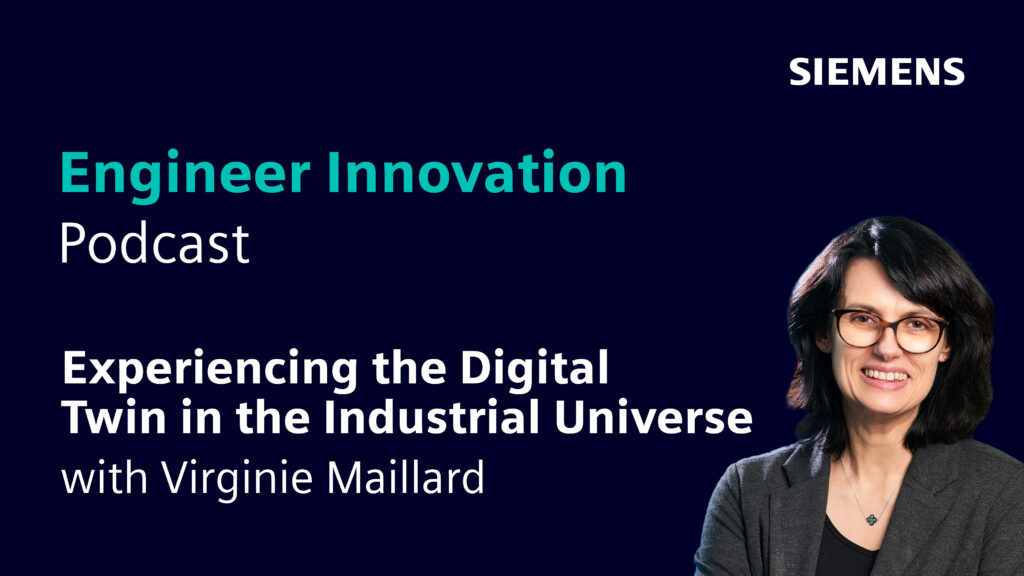
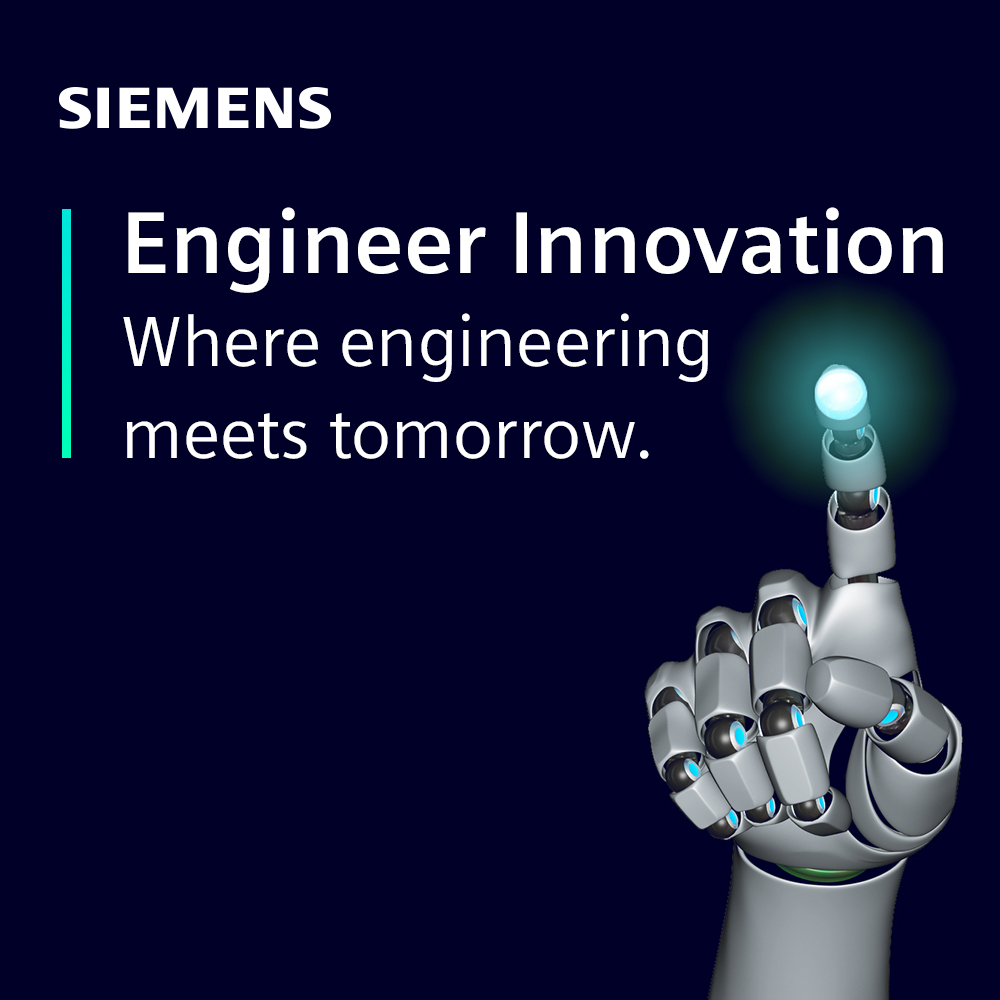
Engineer Innovation Podcast
A podcast series for engineers by engineers, Engineer Innovation focuses on how simulation and testing can help you drive innovation into your products and deliver the products of tomorrow, today.
